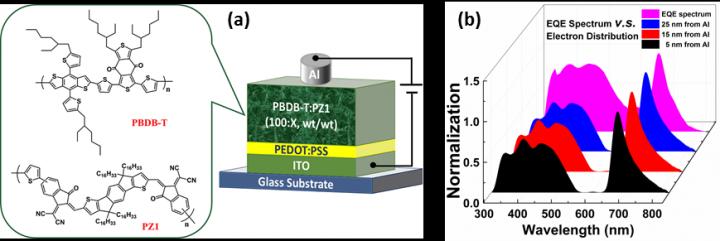New breakthrough: Photomultiplication type all-polymer photodetectors with single carrier transport

(a) The chemical structures of active layer components and the device configuration diagram of the PM type all-PPDs; (b) the normalized photogenerated electron distribution on different cross-sections (5, 15 and 25 nm away from the Al electrode) and the normalized EQE spectrum of PM type all-PPDs. Credit: ©Science China Press
The photodiode type PPDs obeying photovoltaic effect exhibit external quantum efficiency (EQE) of less than 100%, which limits their applications in weak light detection. Thus researchers have been looking for better alternatives and have identified photomultiplication (PM) type PPDs as a promising direction.
PM phenomenon is desirable for sensitive photodetectors with strong detection capability of weak light, which can avoid the use of complex pre-amplifier circuit, simplify the design of photo-detection systems and benefit the development of integrated optoelectronic products.
In 2015, Professor Fujun Zhang's group from Beijing Jiaotong University firstly reported the PM type PPDs with P3HT:PCBM (100:1, wt/wt) as active layers, processing single carrier transport property.
This PM type PPDs exhibit EQE of >>100% and low dark current density. Subsequently, tremendous efforts on PM type PPDs were devoted in the performance improvement, response spectral range regulation, and function expansion. The reported PM type PPDs with single carrier transport property are primarily based on polymer donor P3HT system.
It is urgent to explore new polymer material systems with PM phenomenon, which will further confirm the universality of PM type PPDs with single carrier transport property.
Recently, Professor Fujun Zhang's group developed the PM type PPDs with single carrier transport property, demonstrating the PM type all-polymer photodetectors (all-PPDs) with the sandwich structure of ITO/PEDOT:PSS/PBDB-T:PZ1 (100:x, wt/wt)/Al (Figure 1a).
The optimal all-PPDs with PBDB-T:PZ1 (100:1, wt/wt) as active layers exhibit EQE exceed 100% in the spectral range from 310 to 790 nm. Under 675 nm light illumination, the champion EQE value arrives to 1470%. The photogenerated electron distribution in active layer was simulated by using Transfer Matrix method.
The normalized response spectrum of PM type all-PPDs and normalized photogenerated electron distribution near the Al electrode are exhibited in Figure 1b, which further indicates that the working mechanism of PM type all-PPDs is hole tunneling injection assisted by interfacial band bending induced by trapped electrons in PZ1 near Al electrode. When the number of holes flowing through the all-PPDs is greater than the number of incident photons per unit time, the EQE values will be larger than 100%, leading to the PM phenomenon.
This work further confirms the universality of PM type PPDs with single carrier transport property, which would promote the exploration of new polymer semiconductors and the design of new device architectures to realize high performance PM type PPDs, meeting the need of versatility in integrated optoelectronic products.
###
This research was funded by the Fundamental Research Funds for the Central Universities (2019YJS207).
See the article: Miao J, Du M, Fang Y, Zhang X, Zhang F. Photomultiplication type all-polymer photodetectors with single carrier transport property. Sci. China Chem., 2019, DOI: 10.1007/s11426-019-9582-7. https:/
Media Contact
More Information:
http://dx.doi.org/10.1007/s11426-019-9582-7All latest news from the category: Physics and Astronomy
This area deals with the fundamental laws and building blocks of nature and how they interact, the properties and the behavior of matter, and research into space and time and their structures.
innovations-report provides in-depth reports and articles on subjects such as astrophysics, laser technologies, nuclear, quantum, particle and solid-state physics, nanotechnologies, planetary research and findings (Mars, Venus) and developments related to the Hubble Telescope.
Newest articles

A universal framework for spatial biology
SpatialData is a freely accessible tool to unify and integrate data from different omics technologies accounting for spatial information, which can provide holistic insights into health and disease. Biological processes…

How complex biological processes arise
A $20 million grant from the U.S. National Science Foundation (NSF) will support the establishment and operation of the National Synthesis Center for Emergence in the Molecular and Cellular Sciences (NCEMS) at…

Airborne single-photon lidar system achieves high-resolution 3D imaging
Compact, low-power system opens doors for photon-efficient drone and satellite-based environmental monitoring and mapping. Researchers have developed a compact and lightweight single-photon airborne lidar system that can acquire high-resolution 3D…





















